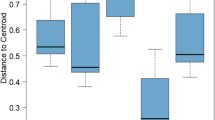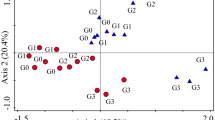Abstract
The aim of this paper was to assess biodiversity among different habitats of an organic farm and the relationships between some soil properties, nematode taxonomic diversity, and soil food web condition. Eight habitats were studied in the farm: ponds, ditches, a riparian corridor, hedgerows, and four agricultural fields (mustard, oats, fallow, and legumes). The undisturbed riparian corridor had higher soil \({\text{NO}}_{\text{3}}^ - - {\text{N}}\) and \({\text{NH}}_4^ + - {\text{N}}\) concentrations, and potentially mineralizable N and higher abundances of bacterivore nematodes and longer food webs. Canonical correlation analysis showed associations between habitats and nematode trophic groups: predatory and bacterial-feeding nematodes in the riparian corridor and hedgerows, omnivore nematodes in the ponds and ditches, and fungal-feeding nematodes in the legume field. Soil chemical and physical properties mirrored the aboveground farm patterns and were more similar among habitats that were or had been cultivated, compared to the riparian corridor. Soil food web indices, based on functional analysis of nematode faunal composition, reflected the aboveground landscape heterogeneity. Discriminant analysis indicated that soil food web indices separated the two most disturbed habitats (ponds and tailwater ditches) from the two least disturbed habitats (the riparian corridor and hedgerows). The indices correlated with soil functioning as inferred by soil properties. Abundance of nematode taxa was not associated with aboveground landscape patterns. The complexity of the soil food web may have been influenced by (1) environmental factors that differed between years, (2) different time periods since disturbance in the various habitats, and (3) movement of nutrients and organisms by water flow between habitats in the farmscale.



Similar content being viewed by others
References
Appuhn A, Joergensen RG (2006) Microbial colonisation of roots as a function of plant species. Soil Biol Biochem. 38:1040–1051
Barker KR (1985) Nematode extraction and bioassays. In: Barker KR, Carter CC, Sasser JN (eds) An advanced treatise on meloidogyne. Vol. 2. Methodology. North Carolina State University Graphics, Raleigh, NC, USA, pp 19–35
Bengtsson J, Ahnstrom J, Weibull AC (2005) The effects of organic agriculture on biodiversity and abundance: a meta-analysis. J Appl Ecol 42:261–269
Berkelmans R, Ferris H, Tenuta M, van Bruggen AHC (2003) Effects of long-term crop management on nematode trophic levels other than plant feeders disappear after 1 year of disruptive soil management. Appl Soil Ecol 23:223–235
Bongers T, Bongers M (1998) Functional diversity of nematodes. Appl Soil Ecol 10:239–251
Bossio DA, Scow KM (1995) Impact of carbon and flooding on the metabolic diversity of microbial communities in soils. Appl Environ Microbiol 61:4043–4050
Breure AM, Mulder C, Römbke J, Ruf A (2005) Ecological classifications and assessment concepts in soil protection. Ecotox Environ Safety 62:211–229
Brussaard L (1998) Soil fauna, guild, functional groups and ecosystem processes. Appl Soil Ecol 9:123–135
Brussaard L, Noordhuis R, Geurs M, Bouwman LA (1995) Nitrogen mineralization in soil microcosm with or without bacteriovorous nematodes and nematophagous mites. Acta Zool Fenn 196:15–21
Brussaard L, de Ruiter PC, Brown GG (2007) Soil Biodiversity for agriculture sustainability. Agric Ecosyst Environ 121:233–244
Burger M, Jackson LE (2003) Microbial immobilization of ammonium and nitrate in relation to ammonification and nitrification rates in organic and conventional cropping systems. Soil Biol Biochem 35:29–36
Cragg RG, Bardgett RD (2001) How changes in soil faunal diversity and composition within a trophic group influence decomposition processes. Soil Biol Biochem 33:2073–2081
Didden WAM, Marinissen JCY, Vreekenbuijs MJ, Burgers SLGE, Defluiter R, Geurs M, Brusaard L (1994) Soil mesofauna and macrofauna in 2 agricultural systems - Factors affecting population dynamics and evaluation of their role in carbon and nitrogen dynamics. Agric Ecosyst Environ 51:171–186
Ekschmitt K, Bakonyi G, Bongers M, Bongers T, Boström S, Dogan H, Harrison A, Nagy P, O’Donnell AG, Papatheodorou EM, Sohlenius B, Stamou GP, Wolters V (2001) Nematode community structure as indicator of soil functioning in European grassland. Eur J Soil Biol 37:263–268
Ekschmitt E, Stierhof T, Dauber J, Kreimes K, Wolters V (2003) On the quality of soil biodiversity indicators: abiotic parameters as predictor of soil faunal richness at different spatial scales. Agric Ecosyst Environ 98:273–283
ESRI (2005) Arcview. ESRI, Redlands, CA, USA
Ferris H, Bongers T (2006) Nematode indicators of organic enrichment. J Nematol 38:3–12
Ferris H, Matute MM (2003) Structural and functional succession in the nematode fauna of a soil food web. Appl Soil Ecol 23:93–110
Ferris H, Venette RC, Lau SS (1997) Population energetics of bacterial-feeding nematodes: Carbon and nitrogen budgets. Soil Biol Biochem 29:1183–1194
Ferris H, Bongers T, de Goede RGM (2001) A framework for soil food web diagnostics: extension of the nematode faunal analysis concept. Appl Soil Ecol 18:13–29
Ferris H, Venette RC, Scow KM (2004) Soil management to enhance bacteriovore and fungivore nematode populations and their nitrogen mineralisation function. Appl Soil Ecol 25:19–35
Fiscus DA, Neher DA (2002) Distinguishing sensitivity of free-leaving soil nematode genera to physical and chemical disturbances. Ecol Appl 12:565–575
Fitter AH, Gilligan CA, Hollingworth K, Kleczkowski A, Twyman RM, Pitchford JW, the members of the Nerc Soil Biodiversity Program (2005) Biodiversity and ecosystem function in soil. Funct Ecol 19:369–377
Forge TA, Simard SW (2001) Structure of nematode communities in forest soils of southern British Columbia: relationships to nitrogen mineralization and effects of clearcut harvesting and fertilization. Biol Fert Soils 34:170–178
Fu S, Ferris H, Brown D, Plant R (2005) Does positive feedback effect of nematodes on the biomass and activity of their bacteria prey vary with nematode species and population size? Soil Biol Biochem 37:1979–1987
Fuller RM, Devereux BJ, Gillings S, Amable GS, Hill RA (2005) Indices of bird-habitat preference from field surveys of birds and remote sensing of land cover: a study of south-eastern England with wider implications for conservation and biodiversity assessment. Global Ecol Biogeogr 14:223–239
Hánĕl L (1995) Secondary succesional stages of soil nematodes in cambisols of south Bohemia. Nematologica 41:197–218
Hánĕl L (2003) Recovery of soil nematode populations from cropping stress by natural secondary succession to meadow land. Appl Soil Ecol 22:255–270
Hunt HW, Wall DH (2002) Modelling the effects of loss of biodiversity on ecosystem function. Global Change Biol 8:33–50
Kapusta P, Sobczyk L, Rozen A, Weiner J (2003) Species diversity and spacial distribution of enchytraeid communities in forest soil: effects of habitat characteristics and heavy metal contamination. Appl Soil Ecol 23:187–198
Levin SA (1992) The problem of pattern and scale in ecology. Ecology 73:1943–1967
Liang WJ, Li Q, Jiang Y, Neher DA (2005) Nematode faunal analysis in an aquic brown soil fertilised with slow-release urea, Northeast China. Appl Soil Ecol 29:185–192
Mäder P, Fliessbach A, Dubois D, Gunst L, Fried P, Niggli U (2002) Soil fertility and biodiversity in organic farming. Science 296:1694–1697
Miranda KM, Espey MG, Wink DA (2001) A rapid, simple spectrophotometric method for simultaneous detection of nitrate and nitrite. Nitric Oxide Biol Chem 5:62–71
Mulder C, Schouten AJ, Hund-Rinke K, Breure AM (2005) The use of nematodes in ecological soil classification and assessment concepts. Ecotoxicol Environ Safety 62:278–289
Neher D (2001) Role of nematodes in soil health and their use as indicators. J Nematol 33:161–168
Okada H, Ferris H (2001) Effect of temperature on growth and nitrogen mineralization of fungi and fungal-feeding nematodes. Plant Soil 234:253–262
Olsen SR, Sommers LE (1982) Phosphorus. In: Page AL (ed) Methods of soil analysis: Part 2. Chemical and microbiological properties. ASA Monograph Number 9, Madison, WI, pp 403–430
Pella E (1990) Combustion gas analyzer method for total carbon and total nitrogen. In: Pella E (ed) Elemental organic analysis 1. Historical Developments. Am. Lab, pp 1–16
Popovici I, Ciobanu M (2000) Diversity and distribution of nematode community in grassland from Romania in relation to vegetation and soil characteristics. Appl Soil Ecol 14:27–36
Postma-Blaauw MB, de Vries FT, de Goede RGM, Bloem J, Faber JH, Brussaard L (2005) Within-trophic group interactions of bacterivorous nematode species and their effects on the bacterial community and nitrogen mineralization. Oecologia 142:428–439
Rhoades JD (1982) Soluble salts. In: Page AL (ed) Methods of soil analysis: Part 2. Chemical and microbiological properties. ASA Monograph Number 9, Madison, WI, pp 167–179
Sánchez-Moreno S, Minoshima H, Ferris H, Jackson LE (2006) Linking soil properties and nematode community composition: effects of soil management on soil food webs. Nematology 8:703–715
Savin MC, Gorres JH, Neher DA, Amador JA (2001) Uncoupling of carbon and nitrogen mineralization: role of microvorous nematodes. Soil Biol Biochem 33:1463–1472
Shannon CE (1948) A mathematical theory of communication. Bell Syst Tech J 27:379–423
Simpson EH (1949) Measurement of diversity. Nature 163:688
Smukler S, Jackson L, Murphee L, Yokota R, Koike S, Smith R (2007) Transition to large-scale organic vegetable production in the Salinas Valley. Agric Ecosyst Environ (in press)
Soil Survey Staff (2006) National soil survey handbook. US Department of Agriculture, Natural Resources Conservation Service. http://soils.usda.gov/technical/handbook/
StatSoft I (1996) Statistica for Windows (Computer Program Manual). StatSoft I, Tulsa, OK, 74104, USA
Steenwerth KL, Jackson LE, Calderon FJ, Stromberg MR, Scow KM (2003) Soil microbial community composition and land use history in cultivated and grassland ecosystems of coastal California. Soil Biol Biochem 35:489–500
Stirling GR, Lodge GM (2005) A survey of Australian temperate pastures in summer and winter rainfall zones: soil nematodes, chemical, and biochemical properties. Austr J Soil Res 43:887–904
Tenuta M, Ferris H (2004) Sensitivity of nematode life-history groups to ions and osmotic tensions of nitrogenous solutions. J Nematol 36:85–94
USDA-SCS (1972) Soil survey of Yolo County, California. Washington, DC USDA, Soil Conservation Service, in cooperation with University of California Agricultural Experiment Station, 102 pp
US Salinity Laboratory Staff (1954) pH reading of saturated soil paste. In: Richards LA (ed) Diagnosis and improvement of saline and alkali soils. USDA Agricultural Handbook 60. US Government Printing Office, Washington, DC, USA, p 102
Van Mansvelt JD, Stobbelaar DJ, Hendriks K (1998) Comparison of landscape features in organic and conventional farming systems. Lands Urban Plan 41:209–227
Vance ED, Brookes C, Jenkinson DS (1987) An extraction method for measuring soil microbial biomass carbon. Soil Biol Biochem 19:703–708
Wang KH, McSorley R, Marshall A, Gallaher RN (2006) Influence of organic Crotalaria juncea hay and ammonium nitrate fertilizers on soil nematode communities. Appl Soil Ecol 31:186–198
Wardle DA, Yeates GW, Watson RN, Nicholson KS (1995) The detritus food web and the diversity of soil fauna as indicators of disturbance regimes in agro-ecosystems. Plant Soil 170:35–43
Wardle DA, Yeates GW, Williamson W, Bonner K (2003) The response of a three trophic level soil food web to the identity and diversity of plant species and functional groups. Oikos 102:45–56
Waring SA, Bremner JM (1964) Ammonium production in soil under waterlogged conditions as index of nitrogen availability. Nature 201:951–952
Yeates GW, Bongers T, de Goede RGM, Freckman DW, Georgieva SS (1993) Feeding habits in soil nematode families and genera- An outline for soil ecologists. J Nematol 25:315–331
Yeates GW, Bardgett RD, Cook R, Hobbs PJ, Bowling PJ, Potter JF (1997) Faunal and microbial diversity in three Welsh grassland soils under conventional and organic management regimes. J Appl Ecol 34:453–470
Zelenev VV, Berkelmans R, van Bruggen AHC, Bongers T, Semenov AM (2004) Daily changes in bacterial-feeding nematode populations oscillate with similar periods as bacterial populations after a nutrient impulse in soil. Appl Soil Ecol 26:93–106
Acknowledgements
We greatly appreciate the cooperation of Bruce Rominger for all his help with the project and for providing full access to his farm. Many students in the Jackson Laboratory are thanked for assisting with sampling. Funding was provided by grant 04-51106-02242 from the USDA CSREES Integrated Organic Program. The work was also supported in part by N.S.F. grant DEB-0120169 and by USDA grant 2004-05151.
Author information
Authors and Affiliations
Corresponding author
Rights and permissions
About this article
Cite this article
Sánchez-Moreno, S., Smukler, S., Ferris, H. et al. Nematode diversity, food web condition, and chemical and physical properties in different soil habitats of an organic farm. Biol Fertil Soils 44, 727–744 (2008). https://doi.org/10.1007/s00374-007-0256-0
Received:
Revised:
Accepted:
Published:
Issue Date:
DOI: https://doi.org/10.1007/s00374-007-0256-0




